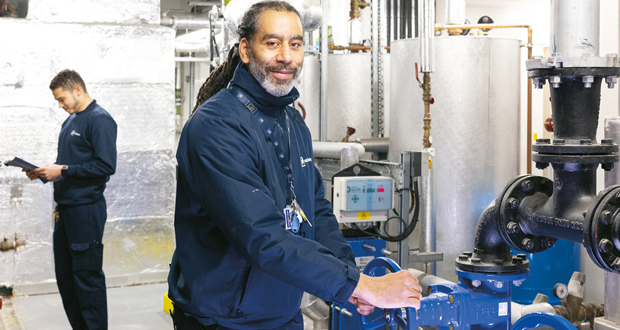SIMPLICITY CAN BE KEY
Digital maintenance works for all buildings – from a small building which has only basic energy data, all the way up to large estates with expansive BMS networks, integrated systems, and advanced energy monitoring.
At NG Bailey, some of the biggest improvements for customers has come from the analysis of basic energy data and the updating of a time schedule, so assets are only in use when the building is occupied. Across larger estates we work with customers to deploy a range of smart building technologies to collect, integrate and analyse data focused on more complex and wider scale changes to achieve their overall end targets.
For one customer, we monitor energy and BMS data 24/7 via our Technical Operations Centre and issue live reports and updates to both the customer and our on-site engineers on asset performance. If asset performance changes or there is an opportunity to make an improvement, we investigate and then act. In this example, within the first days of digital maintenance commencing we had found systems running unnecessarily throughout the day and night, as well as at weekends. Using this data, our on-site engineers immediately corrected the schedules, delivering savings of 9,000 hours of asset run time and 18 per cent associated energy consumption
For another customer, we collect over one billion BMS data points each year and monitor over 2,000 energy meters as part of a programme of digital maintenance, energy management and carbon reduction projects. By monitoring assets more closely and unlocking previously unseen data, we’ve helped our customer make changes that have saved 10,500,000 kWh of energy and led to a 25 per cent reduction in heating, ventilation and air conditioning (HVAC) call outs, as well as identifying over 360 project opportunities for carbon and energy reduction.
Access to this level of data is incredibly powerful, giving us a 24/7, 365-day view of how a building and its individual assets are performing. But data alone cannot make the improvements needed. That’s why access to a complex platform is often meaningless without an actionable maintenance plan built around the data.
Effective delivery of digital maintenance involves speeding up the triage of data into action, which requires effective integration with the engineers on site. These are the people who work with these assets day on day and can deliver the changes needed for success.
Digital maintenance means less of the engineers’ time is spent on reactive call outs, freeing up their time to focus on proactive projects, such as those that advance savings in energy and carbon. We’ve found that this has had positive effects on employee engagement, as engineers have more capacity to work on projects that deliver real change and allow them to see the benefits of their hard work.
We are also working on innovations that shrink the gap between data and action even further. On one of the first net zero sites in the UK we are working with engineers to provide them with video headsets, which will allow direct two-way communication with the engineering design teams involved in the project and access drawings and data while physically standing in front of the asset. This technology helps us increase our knowledge sharing bandwidth and allows us to turn data into action in real time.
NEXT STEPS FOR FM PROVIDERS
As FM providers face ever growing challenges, it is vital to employ effective solutions that can deliver improvements at scale. By identifying simple goals and objectives from the data and collaborating with stakeholders – from service providers to engineers on the ground – it is possible for data to realise outstanding performance improvements. In turn, by ensuring our buildings really are the smartest they can be, we are not only helping to transform the building maintenance sector for the better but for the planet too.






